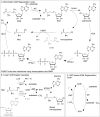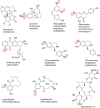Methyltransferases: Functions and Applications
- PMID: 35691829
- PMCID: PMC9539859
- DOI: 10.1002/cbic.202200212
Methyltransferases: Functions and Applications
Abstract
In this review the current state-of-the-art of S-adenosylmethionine (SAM)-dependent methyltransferases and SAM are evaluated. Their structural classification and diversity is introduced and key mechanistic aspects presented which are then detailed further. Then, catalytic SAM as a target for drugs, and approaches to utilise SAM as a cofactor in synthesis are introduced with different supply and regeneration approaches evaluated. The use of SAM analogues are also described. Finally O-, N-, C- and S-MTs, their synthetic applications and potential for compound diversification is given.
Keywords: S-adenosyl-l-methionine; biocatalysis; enzymes; methyltransferases.
© 2022 The Authors. ChemBioChem published by Wiley-VCH GmbH.
Conflict of interest statement
The authors declare no conflict of interest.
Figures














Similar articles
-
S-adenosyl-methionine-dependent methyltransferases: highly versatile enzymes in biocatalysis, biosynthesis and other biotechnological applications.Chembiochem. 2012 Dec 21;13(18):2642-55. doi: 10.1002/cbic.201200556. Epub 2012 Nov 23. Chembiochem. 2012. PMID: 23180741 Review.
-
Chemoenzymatic synthesis and utilization of a SAM analog with an isomorphic nucleobase.Org Biomol Chem. 2016 Jul 14;14(26):6189-92. doi: 10.1039/c6ob00844e. Epub 2016 Jun 6. Org Biomol Chem. 2016. PMID: 27270873 Free PMC article.
-
Making and breaking carbon-carbon bonds in class C radical SAM methyltransferases.J Inorg Biochem. 2022 Jan;226:111636. doi: 10.1016/j.jinorgbio.2021.111636. Epub 2021 Oct 22. J Inorg Biochem. 2022. PMID: 34717253 Free PMC article. Review.
-
Crystal structure of SAM-dependent methyltransferase from Pyrococcus horikoshii.Acta Crystallogr F Struct Biol Commun. 2017 Dec 1;73(Pt 12):706-712. doi: 10.1107/S2053230X17016648. Epub 2017 Nov 24. Acta Crystallogr F Struct Biol Commun. 2017. PMID: 29199993 Free PMC article.
-
Biocatalytic Alkylation Cascades: Recent Advances and Future Opportunities for Late-Stage Functionalization.Chembiochem. 2020 Oct 15;21(20):2890-2897. doi: 10.1002/cbic.202000187. Epub 2020 May 27. Chembiochem. 2020. PMID: 32459052 Review.
Cited by
-
Methylation Modification in Ornamental Plants: Impact on Floral Aroma and Color.Int J Mol Sci. 2024 Jul 29;25(15):8267. doi: 10.3390/ijms25158267. Int J Mol Sci. 2024. PMID: 39125834 Free PMC article. Review.
-
Generation and characterization of two acid-resistant macrocin O-methyltransferase variants with a higher enzyme activity at 30 °C from Streptomyces fradiae.Comput Struct Biotechnol J. 2024 Aug 22;23:3232-3240. doi: 10.1016/j.csbj.2024.08.020. eCollection 2024 Dec. Comput Struct Biotechnol J. 2024. PMID: 39257526 Free PMC article.
-
Methyl transfer in psilocybin biosynthesis.Nat Commun. 2024 Mar 28;15(1):2709. doi: 10.1038/s41467-024-46997-z. Nat Commun. 2024. PMID: 38548735 Free PMC article.
-
Identification and virus-induced gene silencing (VIGS) analysis of methyltransferase affecting tomato (Solanum lycopersicum) fruit ripening.Planta. 2024 Apr 1;259(5):109. doi: 10.1007/s00425-024-04384-4. Planta. 2024. PMID: 38558186
-
Selective Biocatalytic N-Methylation of Unsaturated Heterocycles.Angew Chem Int Ed Engl. 2022 Nov 25;61(48):e202213056. doi: 10.1002/anie.202213056. Epub 2022 Oct 26. Angew Chem Int Ed Engl. 2022. PMID: 36202763 Free PMC article.
References
-
- Constable D. J. C., Dunn P. J., Hayler J. D., Humphrey G. R., J. L. Leazer Jr. , Linderman R. J., Lorenz K., Manley J., Pearlman B. A., Wells A., Zaks A., Zhang T. Y., Green Chem. 2007, 9, 411–420.
-
- None
-
- Richter M., Nat. Prod. Rep. 2013, 30, 1324–1345; - PubMed
-
- Chen H., Wang Z., Cai H., Zhou C., World J. Microbiol. Biotechnol. 2016, 32, 153; - PubMed
-
- Cantoni G. L., Annu. Rev. Biochem. 1975, 44, 435–451. - PubMed
Publication types
MeSH terms
Substances
Grants and funding
LinkOut - more resources
Full Text Sources

